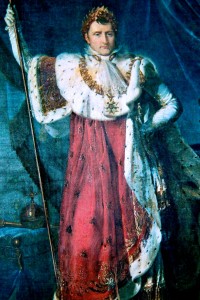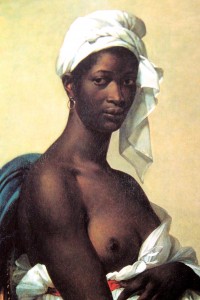 Today, I visited the “Royalists to Romantics” exhibit at the National Museum of the Women in the Arts in Washington, DC. The collection of seventy paintings on loan from the Louvre, Versailles, and other French museums were all produced by women between 1750 and 1850, a time when women artists were marginalized.
Today, I visited the “Royalists to Romantics” exhibit at the National Museum of the Women in the Arts in Washington, DC. The collection of seventy paintings on loan from the Louvre, Versailles, and other French museums were all produced by women between 1750 and 1850, a time when women artists were marginalized.
One of the artists, Marie Guilhelmine Benoist (1768 – 1826) painted this portrait of Napoleon in 1809. She also painted portraits of Napoleon’s sisters Pauline and Elisa, as well as his second wife, Marie Louise. As far as I know, this is the only contemporaneous painting of the Emperor painted by a woman.
Even for that turbulent time, the artist Marie Benoist led an interesting life. Before the French revolution, she had studied under the best-known female and male artists of the time, Élisabeth Louise Vigée LeBrun and Jacques-Louis David. Later, David accused her husband of plotting Queen Marie Antoinette’s rescue. The husband fled the country, returning two years later when the political situation had cooled down. In 1800, she caused a stir with what is now her best known work, the Portrait of a Negress (in the Louvre). After that success, she received commissions to do several essentially propaganda portraits of Napoleon and his family.
 This life-sized portrait of the Emperor, now in the Musée d’Angers, follows the classical mode of a ruler surrounded with symbols of power. In this case, they seem carelessly strewn about. It’s hard to tell from my photo, but in the original, Napoleon’s face appears weary, weak, and worried. He was famously impatient when sitting for his portrait. Perhaps, relaxing in the disarming presence of a woman painter, he forgot to project his customary strength.
This life-sized portrait of the Emperor, now in the Musée d’Angers, follows the classical mode of a ruler surrounded with symbols of power. In this case, they seem carelessly strewn about. It’s hard to tell from my photo, but in the original, Napoleon’s face appears weary, weak, and worried. He was famously impatient when sitting for his portrait. Perhaps, relaxing in the disarming presence of a woman painter, he forgot to project his customary strength.
The contrast to Benoise’s portrait of the partially nude black woman is striking. Inspired by the French abolition of slavery and the unfulfilled promise of women’s rights, her unnamed subject projects power without reliance on false, external trappings. Her manifest dignity is utterly modern.
